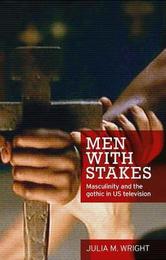
|
Men with Stakes: Masculinity and the Gothic in Us Television
Hardback
Main Details
| Title |
Men with Stakes: Masculinity and the Gothic in Us Television
|
| Authors and Contributors |
By (author) Julia Wright
|
| Physical Properties |
| Format:Hardback | | Pages:200 | | Dimensions(mm): Height 216,Width 138 |
|
| Category/Genre | Television |
|---|
| ISBN/Barcode |
9780719097706
|
| Classifications | Dewey:791.456 |
|---|
| Audience | |
|---|
|
Publishing Details |
| Publisher |
Manchester University Press
|
| Imprint |
Manchester University Press
|
| Publication Date |
1 January 2016 |
| Publication Country |
United Kingdom
|
Description
Men with stakes builds on recent discussions of television Gothic by examining the ways in which the Gothic mode is deployed specifically to call into question televisual realism and, with it, conventional depictions of masculinity. Released from the mandate of realism to describe the world as it is supposed to be, television Gothic calls attention to the constructedness of gender - and therefore to the possibility of re-imagining men's agency, authority and the legitimated forms of knowledge with which men are traditionally associated (science in particular). In this context, after an overview of Gothic television's larger history, this study discusses in some depth seven series from the last two decades: American Gothic, Millennium, Angel, Carnivale, Point Pleasant, Supernatural and American Horror Story. -- .
Author Biography
Julia M. Wright is Professor in the Department of English at Dalhousie University -- .
Reviews'For fans and scholars of the series like Supernatural... the book is a delightful exploration into one aspect of what makes these series so resonant.' Bridget Kies, University of Wisconsin-Milwaukee, Historical Journal of Film, Radio and Television, January 2018 'Men with Stakes is not always about masculinity per se. Chapter four deals with American Gothic television's subversion of Enlightenment concepts such as science and progress and its postmodern blurring of the line between the 'world of signs'-including the televisual medium-and the 'world of the "real"' (p. 124). However, as Wright indicates, many of these dynamics can be understood in gendered terms; she makes an especially fascinating contention that the first season of American Horror Story (2011- present) represents the film and television industry 'as a conventional [patriarchal] gothic villain' (p. 150). Hence, even when Men with Stakes apparently strays from its theme, Wright is in fact adding weight to her central argument that Gothic TV's 'interrogation of masculinity is intertwined with larger examinations of social institutions, cultural assumptions, and established forms of knowledge' (p. 5).' Eve Bennett, Universite Sorbonne Nouvelle, France, Critical Studies in Television: The International Journal of Television Studies -- .
|